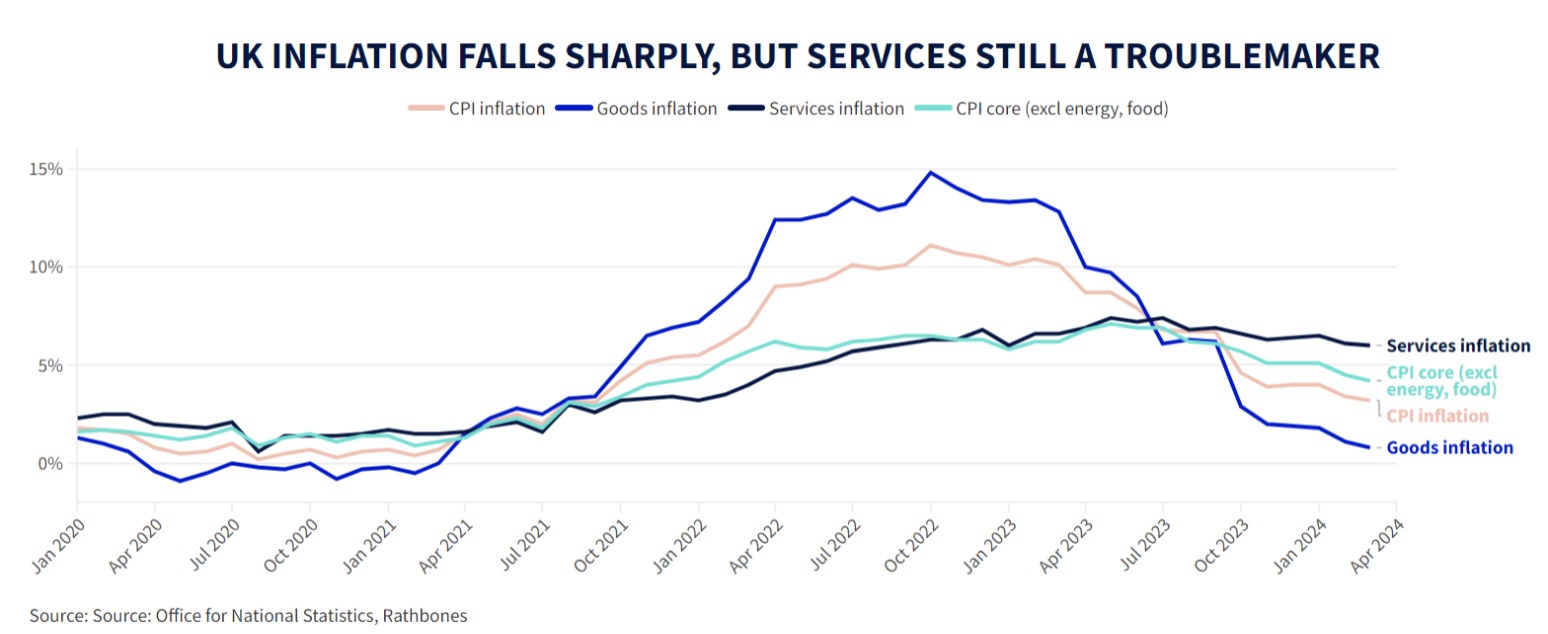
Divergence emerges
US ECONOMIC DATA IS SOFTENING, YET THERE SEEMS A WAY TO GO BEFORE INTEREST RATES START TO FALL. ON THIS SIDE OF THE ATLANTIC IT’S THE COMPLETE OPPOSITE.
Stock markets keep grinding higher, although there have been a few small wobbles in stocks and economic data as the year rolls on. Generally, retail-facing businesses have lagged in recent weeks as evidence of a slowdown for Middle America builds. While the affluent continue to spend with abandon, it appears that middle-class Americans may be starting to be pinched by rising borrowing costs and a slowdown in wage growth and new jobs.
The number of Americans claiming unemployment cheques isn’t particularly high or growing in a meaningful way, which is a good sign for the very short term. But there’s a swathe of leading indicators which signal a potentially significant slowdown in GDP growth later this year.
Earlier in the quarter, employment growth weakened in ‘cyclical’ industries, which are more sensitive to the ups and downs of the economy. There’s also building evidence that short-term work is rising at the expense of full-time, which can often herald cutbacks in staffing. Banks have also tightened their lending criteria, making it harder for households to borrow money to spend. Most recently, American housebuilder sentiment has dipped, with the NAHB Housing Market Index dropping back to 45 from 51 in March (no doubt driven by receding hopes of an interest rate cut in coming months). US credit card delinquencies have reached early-2010 levels for the under-40s after several quarters of rapid growth.
A pervasive emerging theme is one of divergence. The wealthy seem to be steaming on unconcerned by rising prices and higher interest rates. Meanwhile, the less-well-off are starting to struggle. This phenomenon is by no means contained in the US, but can be seen all around the world. It also extends to businesses and nations. The heavily indebted are getting squeezed by high rates, while those that have borrowed little (or are locked into rates well below those that prevail today) and have more savings and investments are benefiting handsomely. This is helping established ‘incumbent’ companies over smaller rivals, and older generations over the younger.
We believe there’s roughly a one-third probability of an American recession in the next year or so (which would likely create a global recession), not what we’re assuming is most likely, but a significant risk nonetheless. This is complicated slightly by the fact that weakening economic news should cool US inflation and therefore allow the US Federal Reserve (Fed) to reduce interest rates and ease the pressure on households and businesses. US inflation eased from 3.5% to 3.4% in April as expected, which helps with that narrative. The Fed releases the minutes of its latest monetary policy meeting on Wednesday, which should give us more insight into the thinking of the world’s most important central bank.
Averages aren’t cutting it
Here in the UK, the economy is growing once again after dipping into a short recession in the second half of last year. Consumer confidence is reasonably strong as expected to be confirmed when the latest data is released this week.
Much of the good cheer is driven by falls in UK inflation, which should continue on Wednesday. It’s forecast to drop substantially to 2.1% from 3.2%, as the 12% drop in the household energy price cap on 1 April flows into the data. While that’s great news, it’s important to note that core inflation – which removes volatile food and energy prices – is expected to remain much higher albeit still falling. Core inflation should fall from 4.2% to 3.7%. Another worrying sign is inflation in the price of services (everything from legal work and car repairs to restaurants and gyms) is still running at roughly 6%. These types of businesses tend to be labour intensive, so stickier inflation can be a sign of wage inflation refusing to cool. Despite this risk, anticipation is growing that the Bank of England will cut rates this summer – August being the most popular pick. If so, it will start to alleviate pressure on the young and indebted, helping boost the economy.

Company results have been ok so far this quarter, depending on how you cut them. The first-quarter US earnings season has helped support stock markets that have defied concerns about just how much US interest rates will fall – and when – this year. However, there is some evidence that shareholders’ assumptions of profit growth may be on the high side – particularly in America.
At the time of writing, more than 90% of the S&P 500 US stock market index had reported their quarterly results. According to FactSet, the average profit growth was 5.7% on a year earlier, the highest in almost two years, yet this obscures an awful lot. Performance remained highly concentrated in the Magnificent Seven largest tech stocks. If you strip out these big players, the rest of the S&P 500’s profits actually decreased 2.4%. Yet if you dig even deeper, a massive fall in the earnings of pharma giant Bristol-Myers Squibb because of a failed drug trial was another outsized effect. If you strip that company out along with the Magnificent Seven the S&P 500’s earnings were virtually stagnant at 0.5%.
There’s a lot resting on the results of AI computer chip designer Nvidia, however, which is the largest contributor to earnings growth for the whole index. FactSet’s earnings numbers above assume a 413% jump in the earnings per share for Nvidia on a year earlier as demand for high-performance chips stays red hot – but the company is one of the last companies to report on Wednesday. With numbers like this, it’s impossible to tell if the company will undershoot, overshoot, or how investors will react.
Looking further out, company analysts are expecting the full S&P 500’s earnings to rise by a bit more than 10% over 2024. They fell 1.4% in 2023 and grew 8.3% the year before. Companies that have beaten their profit forecasts haven’t enjoyed as much of a jump in their share prices as you would normally see. Meanwhile, those that undershoot are selling off much more than usual. Some stocks have even outdone expectations (both their own and those of the analysts covering them) and still fallen – which shows there are some very optimistic investors out there.
Meanwhile, here in the UK stock valuations remain very low indeed, when compared with their history and their overseas rivals. The UK stock market has had a very good few months indeed, especially the large-cap FTSE 100, which benefits from a weaker sterling/stronger dollar because of its predominantly offshore earnings.
One thing’s for certain: averages and generalities really aren’t cutting the mustard, it all depends on the individual circumstances of the companies, households and nations themselves. We think that this phenomenon will endure and think it could reward active investors who can take advantage.
The views in this update are subject to change at any time based upon market or other conditions and are current as of the date posted. While all material is deemed to be reliable, accuracy and completeness cannot be guaranteed.
This document was originally published by Rathbone Investment Management Limited. Any views and opinions are those of the author, and coverage of any assets in no way reflects an investment recommendation. The value of investments and the income from them may go down as well as up and you may not get back your original investment. Fluctuations in exchange rates may increase or decrease the return on investments denominated in a foreign currency. Commissions, trailing commissions, management fees and expenses all may be associated with mutual fund investments. Please read the prospectus before investing. Mutual funds are not guaranteed, their values change frequently, and past performance may not be repeated.
Certain statements in this document are forward-looking. Forward-looking statements (“FLS”) are statements that are predictive in nature, depend upon or refer to future events or conditions, or that include words such as “may,” “will,” “should,” “could,” “expect,” “anticipate,” “intend,” “plan,” “believe,” or “estimate,” or other similar expressions. Statements that look forward in time or include anything other than historical information are subject to risks and uncertainties, and actual results, actions or events could differ materially from those set forth in the FLS. FLS are not guarantees of future performance and are by their nature based on numerous assumptions. The reader is cautioned to consider the FLS carefully and not to place undue reliance on FLS. Unless required by applicable law, it is not undertaken, and specifically disclaimed that there is any intention or obligation to update or revise FLS, whether as a result of new information, future events or otherwise.
